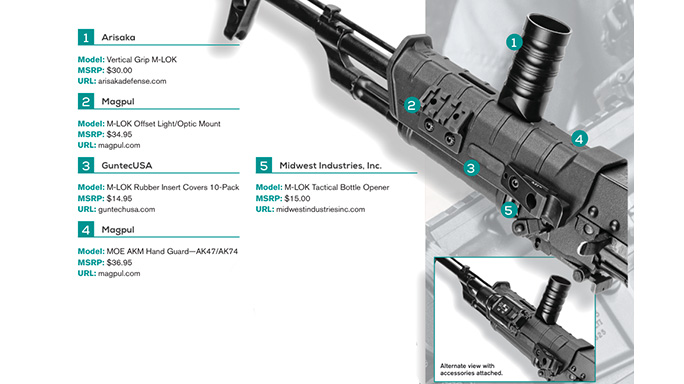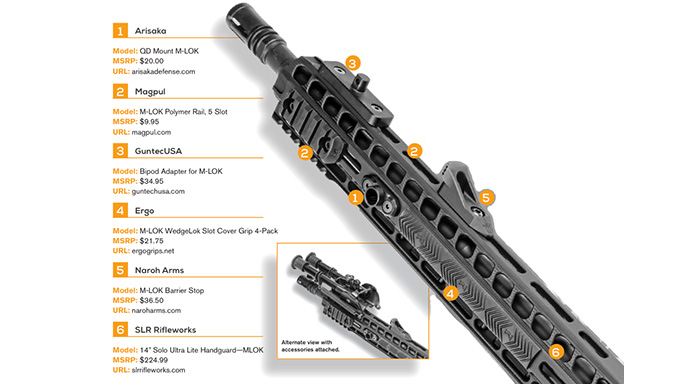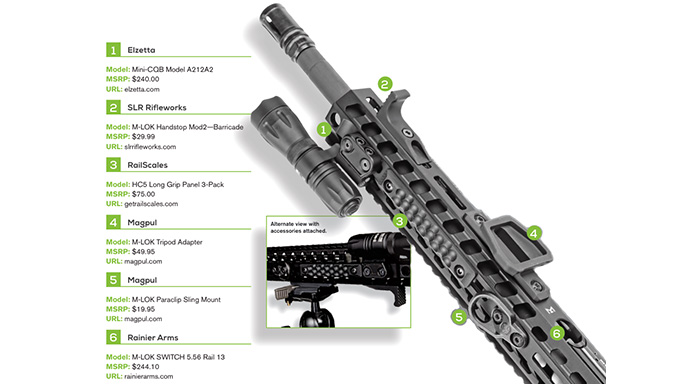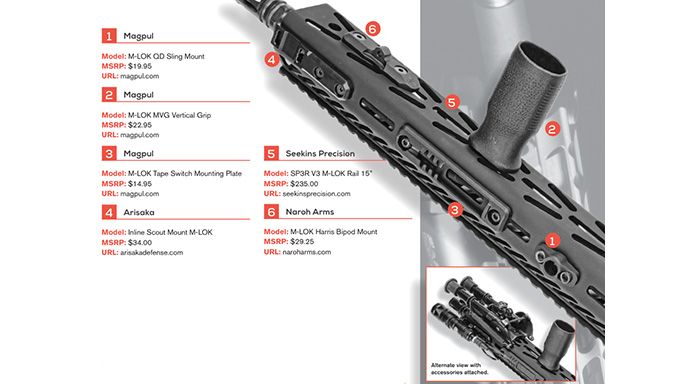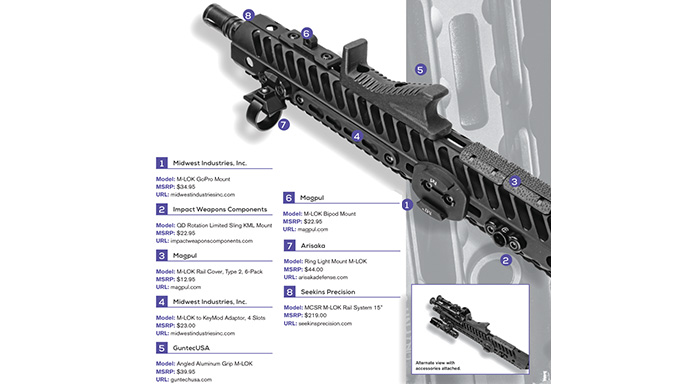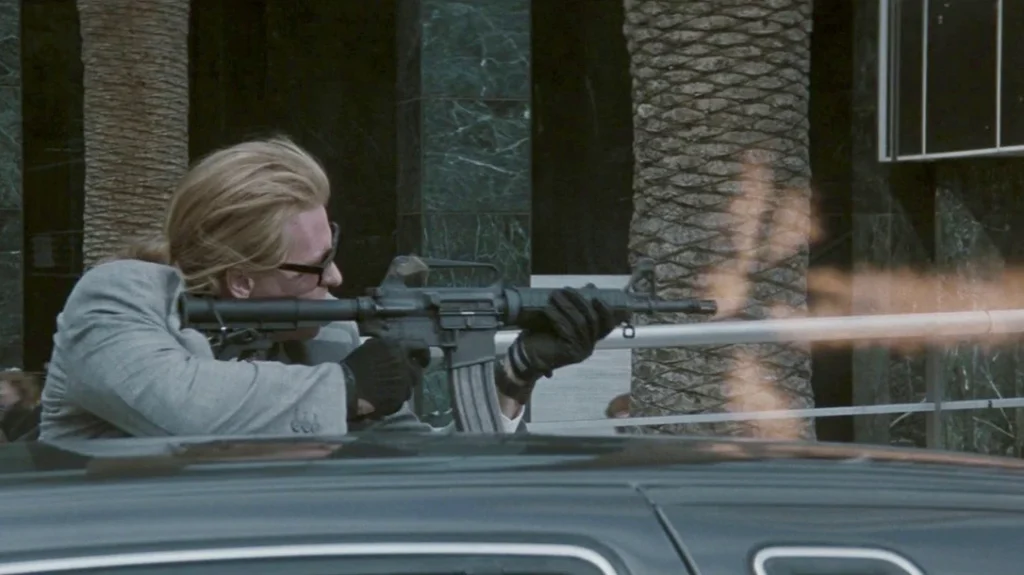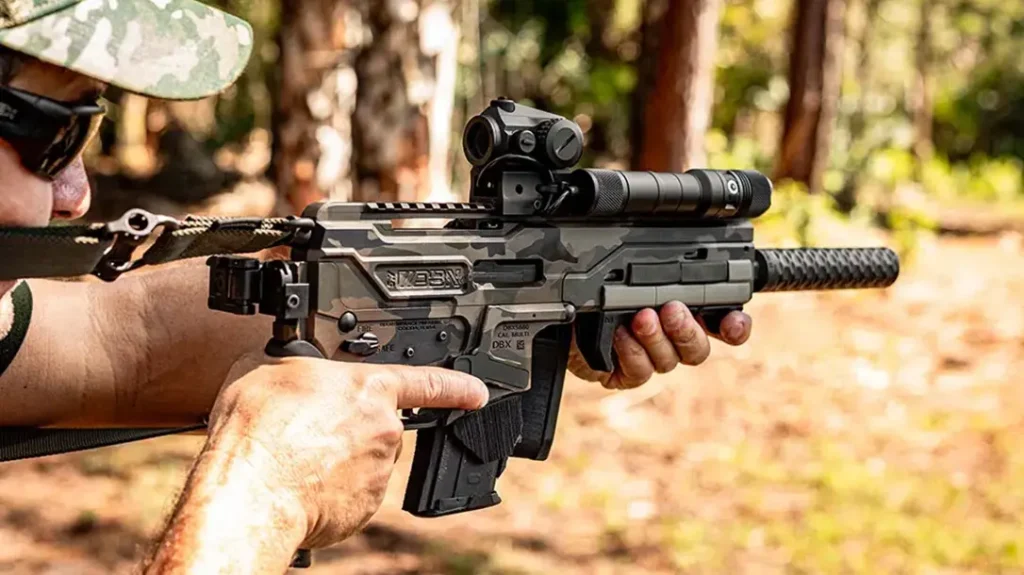They say that competition is good for innovation, and those words couldn’t ring truer than in the firearm industry. New ideas drive advances in design and technology that help solve problems and improve the weapons and equipment we depend on.
- RELATED STORY: Magpul’s Next-Gen M-LOK Accessory Mounting System
The ubiquitous Picatinny rail is an attachment system that has found itself draped over everything from guns to firearm furniture and even coffee mugs. Picatinny rails provide a dependable way to attach all manner of accessories to a firearm, including optics, sights, flashlights, lasers, foregrips and more. A relatively recent move toward ever-lighter rifles has resulted in the portly Picatinny rail system appearing on fewer and fewer guns. The need for an accessory attachment still existed, but quad-rail systems were just too heavy and an alternative was needed.
Magpul Industries, one of the most innovative accessory makers in the firearm industry, accepted the challenge wholeheartedly. As early as 2007, even before many realized that the weight of quad-rail handguards was a problem, Magpul began developing its own slimmed-down attachment system. After a few tries, the company released a free-to-use system called M-LOK. This system promised Picatinny reliability but in a lighter, more modular package.
Advertisement — Continue Reading Below
Join us as we pull the curtain back to reveal the origins of the M-LOK system’s design and development. We spoke with Duane Liptak, Jr., director of product management and marketing for Magpul Industries, to see what it took to get this popular attachment system off the ground and into your hands. If that’s not enough for you, then read on for a complete buyer’s guide showcasing a selection of the latest M-LOK-compatible accessories.
Q: We understand a team helped develop the M-LOK system. Can you tell us more about this group?
A: M-LOK was treated like any other product at Magpul, which means it was a team effort. Everything, of course, starts as an idea that can come from anyone in the company. Requirements that define that product—or in this case, the system—are generated; initial concepts take form in design with inputs from the team; refinements are made for manufacturability, material selections, usability, strength, human interface, aesthetics and other considerations. Concepts are prototyped, tested and refined again, and, eventually, a product emerges that is manufactured, tested more extensively, tweaked and finally released. It’s a great process to be a part of, and although various specific inputs to each product are invariably more critical in what becomes the final product, it truly is the strength of the full team that makes Magpul products what they are. M-LOK was no different, and there were certainly some great ideas and inputs at critical points in development. We are extremely proud to be able to work with individuals of this quality on a daily basis. There are several names on the M-LOK utility patent, but it’s the hard work of the entire team that brought it to life.
Advertisement — Continue Reading Below
Q: What prompted the idea of M-LOK?
A: Our MOE slot system, debuted in 2007 on the Masada concept rifle, was the first “negative space attachment system” that allowed accessory mounting without requiring a surface to be covered with Picatinny rails. We later moved to the MOE system, with millions produced since then, making it the most prolific attachment system on the market next to the Picatinny rail itself. There were some shortcomings to the system, however, like non-uniform spacing of various accessories and the need to have backside access to fasten and adjust accessories, which obviously isn’t ideal for free-float rails and other fixed surfaces.
Other attachment systems, both proprietary and open source, eventually came to market as additional negative space options. We decided that it was time to either adopt one of these systems—a potentially more desirable option if it worked to our requirements—or evolve the MOE slot system into something we felt was better, if our testing of other systems wasn’t deemed satisfactory.
Advertisement — Continue Reading Below
We tested other systems and started working on ideas for updating and evolving the MOE slot system at the same time. One of the requirements for a system that we would move forward with was that it had to work in polymer, which is obviously a significant concern for a company that uses injection molding for a large percentage of our line, but we also tested in metal. After some testing for pullout strength, impact strength, accessory stability and other factors in both polymer and metal, based on the issues we saw, we decided to at least pursue the initial iterations of M-LOK further. After additional tweaking and side-by-side testing in metal and polymer, including live fire, shaker table testing, pullout strength with force gauges, drop testing and other factors, we had what we wanted. Even though we knew it would be a challenge to introduce an entirely new system, we felt the strengths of M-LOK warranted moving forward.
Q: Did the idea deviate in any way from the initial concept?
A: The initial concept for M-LOK started as a pencil drawing over morning coffee but went through a healthy handful of refinements and changes in function and form that were quite different from that initial stab. One of our foundational statements is “Ideas are the easy part,” and that was quite true with M-LOK. Each iteration became better and better until we had the final system, which did incorporate some semblance of the initial spark but was far superior in all ways.
Advertisement — Continue Reading Below
Q: How long did it take from the final concept to the first working prototype?
A: We have a significant ability to prototype in-house, so it was probably less than a week before we had prototypes, but many more tweaks and additional prototypes followed in the refinement of the system. It was still a very rapid program, and we had tested and released the system less than three months after the kickoff. We did both metal and polymer in-house, but Bill Geissele was instrumental in aiding us to vet the system for larger-scale manufacturing in metal. Midwest Industries was another early adopter, and was also a very big part of getting M-LOK off the ground and in circulation. We have a lot of other great partners in M-LOK, and all have been important to its success.
Q: How has the M-LOK system grown or changed the industry?
Advertisement — Continue Reading Below
A: M-LOK provides a lot of advantages from an industry standpoint. It is extremely easy to manufacture, for one, saving machining time in metal and mold costs in polymer. At its heart, M-LOK is merely a series of rounded rectangular slots. Material thickness is not critical. M-LOK works with mounting surface thicknesses from 0.08 to 0.15 inches, allowing appropriate material for proper strength in polymer, metal or carbon fiber. We deliberated for quite a while on how to distribute the system, but finally chose to do so as a free licensing program. This maintains adherence to the technical data package and tolerancing by everyone making mounting surfaces and accessories, so manufacturers have less concern over out-of-spec items causing problems with their products. M-LOK is also incredibly strong, and doesn’t tend to loosen, crack, bend or otherwise damage seating surfaces from overtightening, impact or the shock of drops or firing in a manner that can cause loosening of critical components with some systems.
As a final note, the fact that M-LOK is protected by a Magpul Industries broad utility patent and trademarks provides an additional measure of IP protection to adopters of the system and further helps us to keep all products bearing the M-LOK logo consistent and compatible.
Q: Do you one day feel this will completely replace the Picatinny rail system?
Advertisement — Continue Reading Below
A: There will probably always be a place for the Picatinny rail system, particularly for mounting heavier optics. M-LOK retains zero for accessories which require it with solid recoil lugs in a robust mounting slot with the ability to return to zero within the same tolerances as a Picatinny rail using biasing. Just as you snug a Picatinny accessory forward before tightening, biasing an M-LOK accessory to the top or bottom of a slot and forward provides the same function. The strength of the Picatinny rail, however, is in the mass of the system. Even though M-LOK mounting is extremely robust and can handle the forces of loading bipods and larger accessories like lasers, and provides enough strength to resist the leverage of longer, heavy flashlight bodies, which can amplify the forces of impacts, there’s a lot of material in a Picatinny rail for recoil lugs to act against in hard-recoiling firearms mounting large variable-power optics. That same mass is its greatest drawback, and I believe we will continue to see fewer and fewer handguards with the extra weight of Picatinny rails all over them.
- RELATED STORY: Magpul Releases Compact M-LOK Tripod Adapter
Q: Finally, how does the M-LOK system differ from the KeyMod system?
A: After a significant body of testing, KeyMod just didn’t meet the performance criteria we wanted from a mounting system, so here we are, with M-LOK. With hundreds of licensees and a rapidly expanding list of dozens upon dozens of compatible products in consumer and professional hands, we’re confident we made the right choice in developing it.
Advertisement — Continue Reading Below
